Publication Information
ISSN 2691-8803
Frequency: Continuous
Format: PDF and HTML
Versions: Online (Open Access)
Year first Published: 2019
Language: English
| Journal Menu |
| Editorial Board |
| Reviewer Board |
| Articles |
| Open Access |
| Special Issue Proposals |
| Guidelines for Authors |
| Guidelines for Editors |
| Guidelines for Reviewers |
| Membership |
| Fee and Guidelines |
 |
Assessing cocoa farmers’ perception on changes in phonology and resilience of five desired shade trees in response to climate change: a strategy for mixed plantation and ecosystem restoration in Adansi North District and Offinso Municipality of Ghana
Emmanuel Gyan Ansah1, Daniel Dompreh2*, Victor Rex Barnes1
1 Department of Agroforestry, Faculty of Renewable Natural Resource, KNUST
2 Department of Silviculture and Forest Management, Faculty of Renewable Natural Resource, KNUST
Received Date: December 06, 2023; Accepted Date: December 12, 2023; Published Date: December 18, 2023;
*Corresponding author: Daniel Dompreh. Department of Silviculture and Forest Management, Faculty of Renewable Natural Resource, KNUST. Email: d.dompreh@yahoo.com
Citation: Ansah EG, Dompreh D, Barnes VR (2023); Assessing cocoa farmers’ perception on changes in phonology and resilience of five desired shade trees in response to climate change: a strategy for mixed plantation and ecosystem restoration in Adansi North District and Offinso Municipality of Ghana, Enviro Sci Poll Res and Mang: ESPRM-132
DOI: 10.37722/ESPRAM.2023201
Abstract
Many cocoa farmers in Ghana plant shade trees to create shade, low temperature, less water stress and moist condition to improve cocoa yield. Climate change has affected phenology and resilience of trees in response to changing environmental conditions. This study assessed cocoa farmers’ perception on how changes in phenology and resilience of five most desirable shade trees affect cocoa yield and measures put in place to combat the change in Adansi North District and Offinso municipality of Ghana. A total of 282 cocoa farmers were purposively sampled and interviewed. The result showed that majority of the farmers had existing shade trees before farms were established or were planted at different years after establishing the farm. Majority of farmers (80%) related high cocoa yield to shade trees benefits. About 45.7%, 65.4%, 54.2%, 66.7%, and 52.6% observed changes in phenology of Persea americana, Terminalia ivorensis, Terminalia superba, Milicia excelsa, and Morinda lucida respectively affect cocoa yield and 72%, 43.3%, 74.5%, 34.8% and 39.2% of farmers were that Persea americana, Terminalia ivorensis, Terminalia superba, Milicia excelsa, and Morinda lucida respectively are resilient. Education, gender and experience of respondents has no effect on number of trees on farm. Planting recommended number and types of shade trees are best strategies for ecosystem restoration in response to climate change.
Keywords: Phenology, resilience, cocoa, farmers, shade trees
Introduction
Cocoa (Theobroma cacao L.) grows well under shade and humid environment with long period of rains and short period of drought (Pohlan and Perez, 2010; Mensah et al., 2023). Research by Asare and David (2010) showed that young cocoa trees below three years old and mature trees above four years require about require about 70% shade and 30–40% shade levels respectively to increase yield. High temperature above 30 °C damage cocoa flowers ((Tscharntke et al., 2011). Shade trees therefore play very important role in cocoa production (Kaba, 2020). Climate change can cause shift in leaf phenology, timing of flowering and fruiting of trees (Menezes-Silva et al., 2019). In Ghana, cocoa farmers are encouraged by CoCobod and Forest Extension officers to grow recommended shade trees of 15–18 trees per hectare as best strategies to create humid environmental condition, reduce temperature and water stress in order to improve cocoa yield. Majority of cocoa farmers are actively involved in this practice, however, some cocoa farmers in are rather removing their shade trees from their farms and operating no shade or low shade system which affects cocoa yield ( Obiri et al., 2007; UNDP 2011). Some farmer also grow fruit crops as shade trees for economic benefits (Amanor, 1996). Cocoa farms that combine shade trees with cocoa crop have extended productive lifespans (Somarriba et al., 2021). According to research by Asare (2006), farmers sometimes cultivate shade trees that negatively affect health of cocoa trees due to a lack of knowledge and understanding of changes in phenology and resilience of shade trees. Trees respond differently to changing environmental conditions (Braatz, 2012; Sinasson et al., 2017; Somarriba et al., 2021). therefore knowledge on shade trees will help farmers understand how climate variability affect trees and how trees also respond to changing environmental conditions in order to adopt best management practice to improve cocoa yield in response to finding of Läderach et al. (2013) that climate change might reduce cocoa adaptability to changing environmental conditions in cocoa growing areas in Ghana by 2050. This paper therefore assessed cocoa farmers’ perception on how changes in phenology and resilience of five most desirable shade trees affect cocoa yield and measures put in place by farmers to combat these changes in two major cocoa areas in Ashanti region.
Materials and Methods
Three major cocoa growing communities each from Adansi North district and Offinso Municipality and representing wet and dry semi deciduous zones respectively were selected for the study. Adansi North District lies between latitude 6° 16′ 60.00″ N and longitude -1° 30′ 59.99″ W. Offinso Municipality also lies between longitudes 1o 60′ W and 1o 45′ E and latitudes 7o 20′ N and 6o 50′ S. Annual rainfall and temperature for generally ranges between 1100 mm-1700 mm and 20oC-32oC. The study employed exploratory qualitative research method according to Seuring and Muller (2008) and Maxwell (2012) to collect secondary data on cocoa shade trees in Ghana from newsletters, peer reviewed journals, annual reports. Interviews were conducted using open-ended questionnaires between August, 2019 and June, 2020 to collect demographic information on the farmers, types of shade trees on their farms, farmers’ perceptions about how climate change is affecting phenology and resilience of shade trees, how shade trees affect cocoa farms and yield and management practices put in place in response to climate change. Persea americana, Terminalia ivorensis, Terminalia superba, Milicia excelsa, and Morinda lucida were selected as most common and desired shade tree among farms in the two districts. Out of 957 cocoa growers in the two districts, 282 farmers were selected for the study using Israel’s (1992) formula. Statistical Package for Social Sciences (SPSS) software for Windows (version 22.0.0) was used to analyze data. Responses from interviews were sorted into groups to standardize data before using descriptive statistics for analysis. To evaluate how demographic characteristics and educational level influenced farmers’ perception on changes in phenology and resilience affect cocoa production, a non-parametric Chi Square test was done.
Results
Demographics and frequencies of farmers
Majority of respondents who were actively involved in cocoa farming were males. Most of the farmers achieved basic education of Junior High School before going into farming. The average age of farmers ranged between 46 and 65years and majority of the farmers were natives (Table 1). Though frequency of farmers with shade trees higher and varied with size of farms, majority of farms had shade trees even though Adansi North District than Offinso Municipality (Fig. 2).
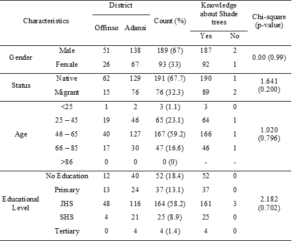
Table 1: Frequencies of demographic characteristics of the respondents in Offinso
Municipality and Adansi North District.
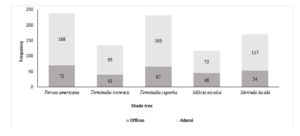
Figure 2: Frequency of farmers with shade trees in the Offinso Municipality and Adansi North district. Size of farms varied
Effects of changes in shade trees’ phenology on cocoa yield
The majority of farmers (54%) who had Persea americana as shade trees reported that they had noticed alterations in the tree’s phenology. Other 25%, 35%, 20% and 16% of the farmers also reported observing changes in phenology of Terminalia ivorensis, Terminalia superba, Milicia excelsa and Morinda lucida respectively. However, in terms of how these changes affected cocoa yield, 65%, 54%, 55%, and 53% observed both positive and negative changes in phenology of Terminalia ivorensis, Terminalia superba, Milicia excelsa, and Morinda lucida respectively on cocoa yield. They explained that period of shedding of leaves of shade trees during dry season from November-January has shifted to January–February. There is less or absence of rain in December therefore shade trees retaining their leaves in this period will provide enough shade to reduce temperature and water stress. However, 46% of farmers observed that changes in flowering period of Persea americana negatively affected their cocoa yield as most of the trees are normally infested with mistletoe that are transmitted to cocoa trees to kill them. Very few farmers agreed to the fact that shade trees help fertilize the soil (Table 2).
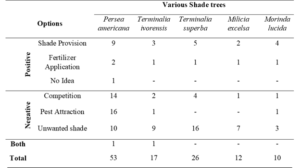
Table 2: Cocoa farmers’ perception on effect of changes in shade tree phenology on cocoa yield in Offinso Municipality and Adansi North District.
Effects of changes in resilience of shade trees on cocoa trees and yield
Farmers’ perception of effect on changes in resilience of shade trees showed that 81%, 45%, 76.6%, 36.9% and 52.1% of cocoa farmers were aware that Persea americana, Terminalia ivorensis, Terminalia superba, Milicia excelsa and Morinda lucida were respectively resilience they affected cocoa yield. Resilience of Persea americana (83.2%), Terminalia ivorensis (85.3%), Terminalia superba (82.4%), Milicia excelsa (81.8%), and Morinda lucida (85.6%) were recorded from the study (Table 3). Some farmers were of the view that shade trees attract pests to the cocoa farm. Weeding around shade trees is one of the management practices used by farmers to encourage resiliency among shade trees to combat climate change. Despite the fact that changes in resilience and phenology of shade trees have increase cocoa yield, most respondents expressed reluctance to this practice. Logistic regression analysis was done to predict reasons for their action.
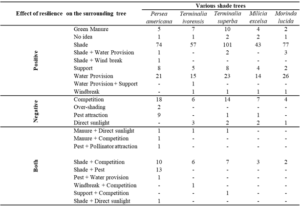
Table 3: Farmers’ perception of effect of resilience of cocoa shade tree on surrounding plants
Gender and Educational level in Offinso Municipality and Adansi North district had no effect on farmers’ perceptions of changes in shade trees’ phenology and resilience. However, more educated farmers complied with recommended number of shade trees per hectare. Cocoa farmers in general were likely to contribute to Persea americana (0.51), Terminalia ivorensis (0.30), Terminalia superba (0.51), Milicia excelsa (0.38), and Morinda lucida (0.19) to improve resilience (Table 4). Cocoa farmers’ contribution to resilience of shade trees in Adansi North district was higher than Offinso Municipality. Women in both districts contributed less to trees’ resilience. Terminalia superba were more resistant to climate change. Persea americana also receive less attention from farmers in terms of contribution to resilience with regards to age of their farms (Table 4).
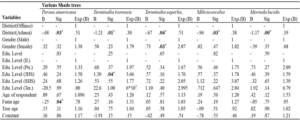
*Significant at 0.05, B= coefficient, Sig. = significance, Exp. (B) = odds ratio. Edu. = educational, IL = Illiterate, Pri. = Primary, JHS = Junior High School, SHS = Senior High School and Ter. = Tertiary
Table 4: Logistic regression analysis of cocoa farmers’ reasons for not contributing to shade trees becoming resilient.
Discussion
Demographic characteristics
A greater number of cocoa farmers were males which is in line with study conducted by Bymolt et al., (2018) where few women were engaged in cocoa farming as compared to males. Majority of respondents (59%) were in the upper age limit of 46 to 65 years and had attained basic education at the Junior High School level. A similar study by Lowe (2017) showed that people enter into cocoa farming as they grow old and one of the reasons to this was access to land and youth negative perception about cocoa farming at younger age.
Effects of changes in phenology and resilience on cocoa yield
A study by Kushwaha et al., (2011) revealed that changes in rainfall pattern due to a changes in environmental conditions delay fruit setting. Most of the cocoa farmers preferred Persea americana among others due its economic benefit as they sell the fruits to support their families apart of other benefits (Table 2). Many farmers had perception that shift in leaf fall period help provide shade in dry season and this help control soil temperature and reduce water stress (Schnabel et al., 2018). This result agrees with Gray and Ewers (2021) that when leaves emerge later than expected, they typically remain on the tree longer to provide shade. More prolonged period of shade as a result of late dropping of leaves of shade trees as compared to previous years coincide with early rainy season in Ghana (March) therefore accumulated leaves are easily converted to humus by decomposing organisms as environmental conditions are favorable. Again, shade trees that shed off leaves earlier than usual also help accumulate organic manure or organic fertilizer in the soil (Asare et al., 2017; Kijowska et al., 2020) to improve yield. This results is in line with study by Fenner (1998) that alterations in the surrounding environment cause delay in leaf fall and the surrounding plants typically benefit from the shade provided. The farmers explained that changes in phenology of the shade trees might be contributing to pest and insects attack of cocoa trees (Daghela Bisseleua, 2013). Due to weather variations, certain trees may flower earlier than anticipated. This can attract insect pollinators at the time cocoa trees are not in flower.
Majority of cocoa farmers (83.2%, 85.3%, 82.4%, 81.8%, and 85.6%) claimed that the resilience of Persea americana, Terminalia ivorensis, Terminalia superba, Milicia excelsa and Morinda lucida, respectively had negative impact on their cocoa trees despite their of benefits of tree resilience. They explained that the shade trees compete with cocoa trees for resources (Isaac, 2007) to achieve resilience in respond to the changing environmental conditions therefore some shade trees are no good for cocoa farms. Work done by Weiskopf et al. (2020) also showed that trees’ reproductive success is decreased as they age but their competition with nearby plants for resources is rather increased in respond to changing environmental conditions. Farmers further explained that they were therefore selective in types of shade trees for their cocoa farms. According to Ghirardo et al. (2022), trees with massive trunk diameters and rough bark will require more resources therefore such trees compete more with the nearby plants for resources.
Conclusion
Majority of farmers are aware that phenology and resilience of the shade trees has changed, and these changes have both positive and negative impact on cocoa yield. Factors including competition for resources, pest attraction, delayed or early shedding of leaves, changes in flowering and fruiting periods of shade trees has changed period of visitation of cocoa flowers by insect pollinators, temperature of cocoa farms and yield. Cocoa yield was positively impacted by prolonged shade and leaves that turns into organic manure by soil microorganisms. Farmers were also aware that some shade trees compete with cocoa trees in achieving resilience in response to changes in environmental conditions especially those that develop large buttress roots. Some farmers were therefore not ready to contribute to resilience of shade trees in their farms. Weeding was the main management practice employed by farmers in helping shade trees become resilient. Farmers prefer fruit crops as shade trees as compared to timber species due to their long term economic benefit from sale of their fruits. However, others were of the view that fruit crops transmit parasites such as mistletoe that kill most of their cocoa trees. With limited availability of lands, supplying seedlings to cocoa farmers with no shade trees or less than the recommended number per hectare is best strategies for planted forests as well as ecosystem restoration in response to climate change at very low cost to the farmer and the government.
Acknowledgement
The study was funded by the Danish Government under the project, Climate-Smart Cocoa Agroforestry Research in Ghana (CLIMCARG) with support from the Danish Ministry of Foreign Affairs through DANIDA. The authors are also grateful to KNUST, Arhus University, Denmark, University of Copenhagen and the Cocoa Research Institute in Ghana for the development of CLIMCARG project.
Conflict of Interest: Authors declare no conflict of interest
References
- Amanor K.S. (1996). Managing trees in the farming system: The perspective of farmers. Forest Farming Series No. 1, Forestry Department, Ghana. Pp. 198.
- Asare R. (2006). Learning about neighbor trees in cocoa growing systems – a manual for farmer trainers. Forest & Landscape Development and Environment Series 4.
- Asare R. and David S. (2010). Planting, replanting and tree diversification in cocoa systems-learning about sustainable cocoa production: a guide for participatory farmer training (No. 13). Forest & Landscape Denmark.
- Asare R., Asare R. A., Asante W. A., Markussen O. and Ræbild A. (2017). Influences of shading and fertilization on on-farm yields of cocoa in Ghana. Experimental Agriculture, 53(3), 416-431.
- Braatz S. (2012). Building resilience for adaptation to climate change through sustainable forest management. Forestry Department, FAO, Rome. Pp. 117 – 127.
- Bymolt R. Laven A. Tyszler M. (2018). Demystifying the Cocoa sector in Ghana and Cote d’Ivoire: Gender and Cocoa. Chapter 14. The Royal Tropical Institute. WRENmedia. kit.nl
- Daghela Bisseleua H. B., Fotio D., Yede, Missoup A. D. and Vidal S. (2013). Shade tree diversity, cocoa pest damage, yield compensating inputs and farmers’ net returns in West Africa. PloS one, 8(3), e56115.
- Fenner M. (1998). The phenology of growth and reproduction in Plants. Journal of Biodiversity and Ecology. Vol. 1/1. Pp. 78-91.
- Ghirardo A. Blande J. D. Ruehr M. K. Balestrini R. and Kulheim C. (2022). Adaptation of tree to climate change: Mechanism behind Physiological and Ecological Resilience and Vulnerability. Fronteir for Global change 4:831701.
- Gray R. E. and Ewers R. M. (2021). Monitoring Forest phenology in a changing World. Forest Review. Vol. 12. Pp. 297 -321.
- Kaba S. J., Otu-Nyanteh A., AbunyewaA. A. (2020). The role of shade trees in influencing farmers’ adoption of cocoa agroforestry systems: Insight from semi-deciduous rain forest agroecological zone of Ghana, Journal of Life Sciences, Volume 92, 100332.
- Kijowska O. J. Staszak M. A. Kaminski J. and Ratajczak E. (2020). Adaptation of Forest Trees to rapidly changing Climate. Forest review. Vol 11. Pp. 1-23.
- Kushwaha C. P. Tripathi S. K. Tripathi B. D. and Singh K. P. (2011). Patterns of tree phenological diversity in dry tropics. Journal of Ecological science. Vol. 31. Pp. 179 -185.
- Läderach P., Martinez-Valle A., Schroth G. and Castro N. (2013). Predicting the future climatic suitability for cocoa farming of the world’s leading producer countries, Ghana and Côte d’Ivoire. Climatic change. 119(3-4), 841-854.
- Lowe A. (2017). “Creating Opportunities for Young People in Ghana’s Cocoa Sector.” Working Paper 511. London: Overseas Development Institute.
- Isaac M. E., Timmer V. R. and Quashie-Sam S. J. (2007). Shade tree effects in an 8-year-old cocoa agroforestry system: biomass and nutrient diagnosis of Theobroma cacao by vector analysis. Nutrient cycling in agroecosystems, 78, 155-165.
- Israel G. D. (1992). Determining sample size.
- Maxwell J.A. (2012). Qualitative Research Design: An Interactive Approach. Sage Publications. London, England.
- Menezes-Silva PE, Loram-Lourenço L, Alves RDFB, Sousa LF, Almeida SEDS, Farnese FS. (2019). Different ways to die in a changing world: Consequences of climate change for tree species performance and survival through an ecophysiological perspective. Ecology and Evolution, 2:9(20), 11979-11999.
- Mensah O. E., Ræbild A, Asare R., Amoatey C. A, Markussen B, Bismark K.O., Asitoakor K. and Vaast P. (2023). Combined effects of shade and drought on physiology, growth, and yield of mature cocoa trees, Science of The Total Environment, Volume 899, 165657.
- Obiri B. D., Bright G. A., McDonald M. A., Anglaaere L. C. and Cobbina J. (2007). Financial analysis of shaded cocoa in Ghana. Agroforestry systems, 71, 139-149.
- Pohlan H.A.J. and Perez V.D. (2010). Growth and production of cacao. Soils, Plant Growth and Crop Production, 3, Pp. 346-377.
- Schnabel F. Filho V. E. Xu S. Fisk I. D. Roupsard O. and Haggar J. (2018). Shade trees: a determinant to the relative success of organic versus conventional coffee production. Journal in Agricultural systems, 1 – 44.
- Seuring, S., & Müller, M. (2008). From a literature review to a conceptual framework for sustainable supply chain management. Journal of cleaner production, 16(15), 1699-1710.
- Somarriba, E., Peguero, F., Cerda, R. et al. (2021). Rehabilitation and renovation of cocoa (Theobroma cacao L.) agroforestry systems. A review. Agronomy for Sustainable Development, 41: 64.
- Sinasson G. K. Shackleton C. M, and Sissin D. (2017). Reproductive phenology of two Mimusapus species in relation to climate, tree diameter and canopy position in Benin West Africa. African Journal of Ecology, Pp.323-333.
- Tscharntke T., Clough Y., Bhagwat S. A., Buchori D., Faust H., Hertel D. and Wanger T. C. (2011). Multifunctional shade‐tree management in tropical agroforestry landscapes–a review. Journal of Applied Ecology, 48(3), 619-629.
- UNDP (2011). Environmental Baseline Report on Cocoa in Ghana, Pp. 144.
- Weiskopf S. R. Rubenstein M. A. Crozier L. G. Gaichas S. Griffs R. Halofsky J. E. Hyde K. J. Morelli T. L. Morisette J. T. Munoz R. C. Pershing A. J. Peterson D. L. Poundel R. Staudinger M. D. Sutton-Grier A. E. Thompson L. Vose J. Weltzin J. F. and Whyte K. P. (2020), Climate change effects on biodiversity, ecosystems, ecosystem services and natural resource management in the United States. Science of Total Environment, Vol 733. Pp. 1 -18.
*Corresponding author: Daniel Dompreh. Department of Silviculture and Forest Management, Faculty of Renewable Natural Resource, KNUST. Email: d.dompreh@yahoo.com